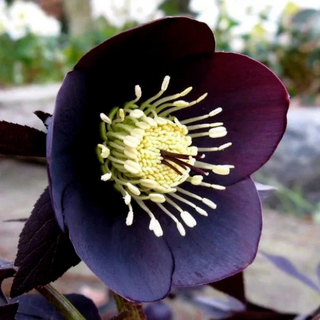RAINBOW PLANT
Byblis aquatica
- Unit price
- / per
Description
Byblis aquatica is an insectivorous plant belonging to the genus Byblis, commonly known as the rainbow plants. It grows in semi-aquatic conditions and uses stalked mucilaginous glands (similar to those employed by the unrelated sundews and Drosophyllum) covering its leaf surfaces to attract, catch, and digest insect prey to supplement the poor environmental nutrient supply.
Byblis aquatica is an annual plant with a usually unbranching central stem supported by fine, fibrous roots. The central stem can reach a length of 45 centimetres (18 in), although it is only able to support its own weight during early growth (<5 cm.). After that it leans on neighboring plants for support, eventually toppling and growing horizontally along the ground or water surface, with only the growth tip growing uprightly.
The plant's leaves are 2–4 centimetres (0.79–1.57 in) long, highly filiform (elongated and narrow), round in cross-section and tapering at the end. Young leaves are bright green and grow uprightly; as they age, they darken to a maroon (color) and droop. The leaf surface is covered with stalked mucilaginous glands along its entire length. These serve not only to attract and trap insect prey, but also allow the plant to "hold on" to neighboring structures for support.
Byblis aquatica flowers are born singly at the tip of 1.5–3-centimetre (0.59–1.18 in) stems similar in appearance to the leaves. These emerge from the leaf axes in mature plants. The five-petaled, deep purple flowers appear between January and May (during the Australian summer).
This species has a very limited distribution in the Australian Northern Territory. It is endemic to the area between Darwin and Berry Springs, but is fairly common there. It grows in the loamy sand of seasonally flooded depressions and in the shallow margins of freshwater lagoons. Here it shares its habitat with B. liniflora. which is however native to dryer regions elsewhere.
Seeds per pack: 5
Germination: These seeds germinate best using a mixture of 50% peat and 50% perlite or sand. Soak the mixture for 1 hour, then gently squeeze out excess water, but allow some moisture to remain (not dripping). Place the moss in a container.
These seeds benefit from a 24 hour soak with 10 PPM of gibberellic acid (a plant hormone). After the treatment, sprinkle the seeds on top of the growing mix, and cover the container with plastic to retain moisture while the seeds germinate. Place the container in very bright light, at 15-30C, 60-85F. Once the small plants begin to grow, slowly open the plastic a little each day. Use rain water or distilled water (use a spritz bottle while plants are small) to regularly water plants. Plants thrive with at least 8-10 hours of direct light, be it artificial or natural. Seeds germinate anywhere from 2-4 months, with a few seeds taking longer. Patience is needed, though they are well worth the wait! These seeds can also be grown without the gibberellic acid treatment, though they can take up to a year to germinate without it.
RAINBOW PLANT
Byblis aquatica
- Unit price
- / per
Multiple secure payment options available.
Adding product to your cart
You may also like
Description
Byblis aquatica is an insectivorous plant belonging to the genus Byblis, commonly known as the rainbow plants. It grows in semi-aquatic conditions and uses stalked mucilaginous glands (similar to those employed by the unrelated sundews and Drosophyllum) covering its leaf surfaces to attract, catch, and digest insect prey to supplement the poor environmental nutrient supply.
Byblis aquatica is an annual plant with a usually unbranching central stem supported by fine, fibrous roots. The central stem can reach a length of 45 centimetres (18 in), although it is only able to support its own weight during early growth (<5 cm.). After that it leans on neighboring plants for support, eventually toppling and growing horizontally along the ground or water surface, with only the growth tip growing uprightly.
The plant's leaves are 2–4 centimetres (0.79–1.57 in) long, highly filiform (elongated and narrow), round in cross-section and tapering at the end. Young leaves are bright green and grow uprightly; as they age, they darken to a maroon (color) and droop. The leaf surface is covered with stalked mucilaginous glands along its entire length. These serve not only to attract and trap insect prey, but also allow the plant to "hold on" to neighboring structures for support.
Byblis aquatica flowers are born singly at the tip of 1.5–3-centimetre (0.59–1.18 in) stems similar in appearance to the leaves. These emerge from the leaf axes in mature plants. The five-petaled, deep purple flowers appear between January and May (during the Australian summer).
This species has a very limited distribution in the Australian Northern Territory. It is endemic to the area between Darwin and Berry Springs, but is fairly common there. It grows in the loamy sand of seasonally flooded depressions and in the shallow margins of freshwater lagoons. Here it shares its habitat with B. liniflora. which is however native to dryer regions elsewhere.
Seeds per pack: 5
Germination: These seeds germinate best using a mixture of 50% peat and 50% perlite or sand. Soak the mixture for 1 hour, then gently squeeze out excess water, but allow some moisture to remain (not dripping). Place the moss in a container.
These seeds benefit from a 24 hour soak with 10 PPM of gibberellic acid (a plant hormone). After the treatment, sprinkle the seeds on top of the growing mix, and cover the container with plastic to retain moisture while the seeds germinate. Place the container in very bright light, at 15-30C, 60-85F. Once the small plants begin to grow, slowly open the plastic a little each day. Use rain water or distilled water (use a spritz bottle while plants are small) to regularly water plants. Plants thrive with at least 8-10 hours of direct light, be it artificial or natural. Seeds germinate anywhere from 2-4 months, with a few seeds taking longer. Patience is needed, though they are well worth the wait! These seeds can also be grown without the gibberellic acid treatment, though they can take up to a year to germinate without it.
You may also like
You may also like
Recommended Products
CUSTOMERS ARE ALSO BUYING THESE
Testimonials
Here's What Some Of Our Customers Had To Say (Thank you!)

Ferri Seeds is truly a wonderful company. They take the utmost care when delivering your seeds. Mine arrived promptly and when I had any questions, they were so happy to help me. I am looking forward to getting more from them soon. Thank you David for making this a delightful experience.

I got these pretty quickly and in perfect order. I can't wait to see what they look like once I plant them. I have another colour and they were so pretty I had to try these. I have used this seller a few times now with great success, and will again. Everything I have ordered has been of good quality!

I was impressed with Ferriseed’s selection of seeds. Ordering was a breeze and the seeds arrived in a perfect little padded envelope in 9 days. I am very happy and will order from here again. Many thanks.

Never grew coleus from seed, and it was surprisingly easy. They germinated quickly on my heat mat and grow lights. Can't wait to see them in the garden!

We placed our order on Thursday and received it on Monday. Here in Canada the tracking link is accurate. Ferri seeds tells you when they're shipping and when your order is delivered, the seeds arriving in excellent condition. We will definitely be ordering again this spring. Keep up the good work!

Great product ! All seeds germinated and flourished nicely.

My order, made late afternoon, April 27th, and needed in a bit of a rush, was mailed next morning and arrived in my rural mailbox in BC, May 5th.
Thank you for your cheerful, friendly emails and prompt service. I certainly recommend you others and will be sure to keep an eye on the range of seeds you offer in future.

Gt the delivery on time. One week since i potted the seeds. Some of the seeds are already sprouting so i am very happy so far. No complaints yet

Thank you Ferri Seeds for the timely shipments of seeds I ordered. I have been looking to replace that plant for years.

Excellent service, (fastest!!) Great packaging. Also very appreciated is all of the information on how to 'deal' with perennial seeds! Will order again!! Thank you

Ferri Seeds – one of the best online and most helpful businesses I have ever had dealings with. Quick turnaround, dispatch, and beautifully packaged seeds. What more could you want – beautiful flowers would be nice. Well I am sure they will turn out to be.

The seeds came just as described. I appreciate the good follow-up to my questions also.

Fantastically seedlings. They were well packaged. I planted them right away and they’re growing nicely so far.

Fast service, amazing communication!

I happened across Ferri Seeds website when I Googled a particular plant I’d been looking for. I was impressed by their selection of all types of seeds and their good product descriptions along with detailed germination instructions. I found the site and ordered on a Saturday. On Sunday I got a notice that my order had been shipped! The seeds were in my P.O. box on Friday. Such amazing service. It’s too early to comment on germination rates — I’ve just started the stratification process today.

Received in 1-2 weeks in Canada, Ontario. Everything is as ordered. No issues. Ordered through the official web site.

The Japanese anemone seeds arrived promptly. Thank you Ferri Seeds!!

Very fast I am excited

Customer service excellent. Was able to order streptocarpus seeds. Hard to find.

Thank you for having showy Asters., Birdsnest Delphiniums and Colbalt Delphiniums and Obedient plant seeds in Stock. My butterfly garden is almost now complete. And I am cold stratificationing the seeds.

I had a herbarium project with a short deadline. Ferri Seeds were professional, friendly and sent me Alstroemeria seeds promptly. The seeds arrived in a protective sleeve within a letter envelope. The herbarium is complete! I highly recommend Ferri Seeds! Thank you!

Very good seller!

Very satisfied, quick service

It's been a pleasure dealing with Ferri Seeds!

Amazing selection. Fast service. I look forward to ordering in the future.
We carry a diverse selection seeds from around the world, many are rare and hard to find!
Regular new seed stock, special cold/dry storage facility, and record keeping ensures our stock is fresh and ready to grow for you.
When you sign up, you are agreeing to receive promotional emails and other marketing communications from us. In the future, you can always unsubscribe.




